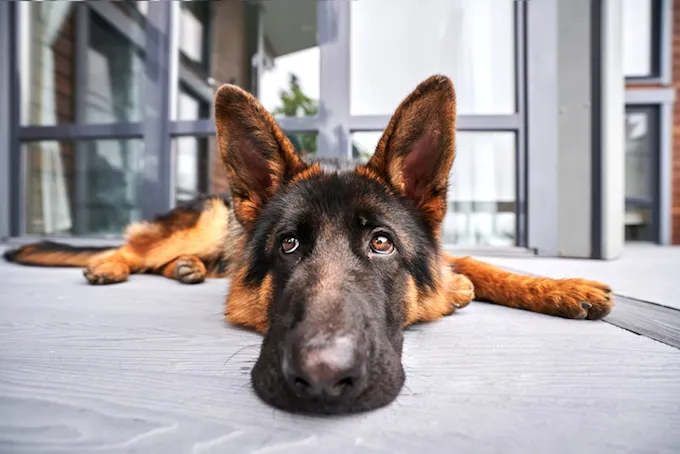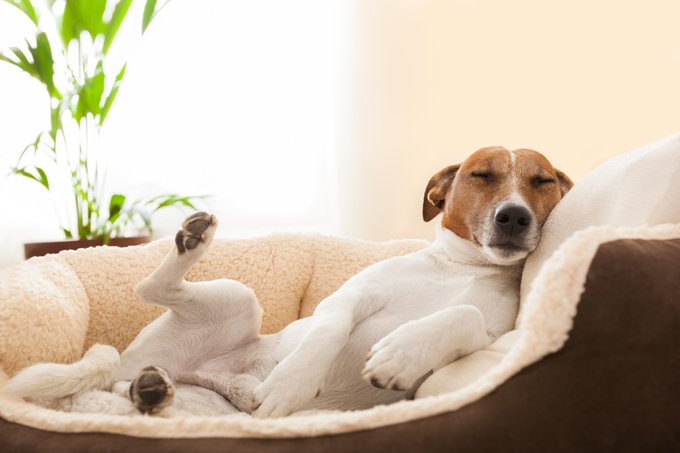
Since canines are highly social creatures, being alone can be quite stressful for them. Fortunately, you can teach your pup to enjoy his alone time, or at least tolerate it. If he never grasps how to do this, you may wind up with a dog who acts out through excessive barking, digging, and chewing – or develops a very serious case of separation anxiety.
Steps to teaching your pup/dog to be alone:
1. Leave your puppy alone in his crate or puppy playroom for at least 30 minutes to an hour each day at first. Gradually increase that length of time to up to two hours for a pup three months and younger, or up to four hours for a pup from three to six months old.
Your pup will begin to adjust to being alone, as well as learn a valuable lesson: you always come back.
We recommend you leave your dog in a safe place, either a roomy crate or puppy playroom, whenever you leave the house until they’re about a year old, though some dogs may need a few extra months of training.
2. Make your pup’s alone time the main time he eats, and he’ll learn to enjoy these stretches more. Using kibble he’d normally get at meals, stuff a couple of Kongs, and give them to your pup whenever you leave him alone.
3. Teach your dog that “quiet time” is a good thing by showing him how to settle down. Every so often, interrupt his playtime with short, quiet breaks. Tell your dog, “settle down,” and ask him to lie still for a second or two. Then reward him and resume playing.
At first, these intervals should be very short – just a few seconds in length. When he’s able to settle successfully for these brief periods, slowly build up to longer segments – 10 to 20 seconds of settling. Your dog soon learns that quiet time is followed by playtime, and the wait is never more than he can handle.
DogTime tip: In the beginning, keep his time alone short (30 minutes at most) so he has no trouble remembering that you’ll be back. Make the experience pleasant by leaving him with two or three stuffed chew toys. Before your pup goes into his crate, make sure all his needs are met–that he’s emptied his bladder and bowels and has had water and some playtime. If he cries, at least you’ll know he’s not thirsty, uncomfortable, or unattended to.
Troubleshooting
My puppy was doing well–until he stopped. Now he cries every time I leave:
Chances are you went too far, too fast. Wait for a break in the crying before going back in. One he’s re-engaged with his chew toys or settled down, take another much shorter break from the room.
At your next alone time training, begin with a length of time you know your puppy handles easily and practice at that level for several sessions. Once he’s got that down, gradually add on just a bit at a time, stopping just short of when he becomes anxious.
My puppy works himself into a frenzy when I leave him alone.
This may well be a normal puppy reaction to your absence–they can kick up an amazing mini-storm when they’re first left alone. You might also be surprised by how long it takes him to get to a break in his vocalizing–5 or 10 minutes is normal, but it can seem like an eternity when it’s your baby howling and shrieking.
Many dogs will paw or chew on the kennel door in an attempt to come to you, but stop when it’s clear it won’t be successful.
These behaviors, upsetting though they may be, are to be expected when you’re first starting this type of training. Follow the above steps, make sure you don’t keep your puppy in his crate for too long, and make sure the toys you give him when you leave are well stuffed and beloved.
Symptoms your dog may have separation anxiety, and need a dog trainer’s help:
- He’s not eating food or treats left out while you’re away
- Destructive chewing, scratching, or clawing at exit routes–doorways, windowpanes, or the kennel door. If your dog’s nails, pads, or teeth are worn down or bloody, or he’s panting from exhaustion, he’s suffering real separation anxiety.
- Pacing, whining, drooling, and following you closely when you’re getting ready to leave









